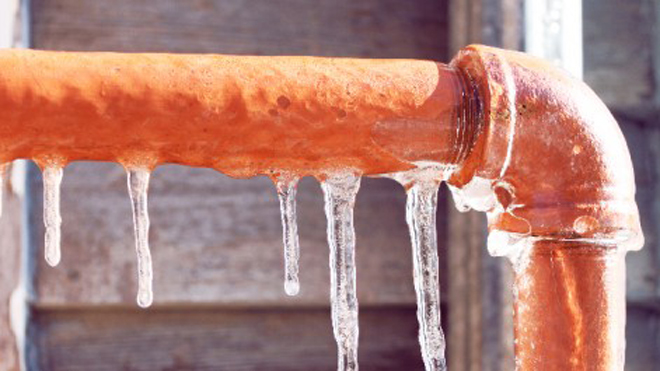Protecting Against Frozen Plumbing in Winter: Essential Strategies
Protecting Against Frozen Plumbing in Winter: Essential Strategies
Blog Article
They are making several great points about Preventing and dealing with frozen pipes overall in this content just below.
.jpg)
Winter can wreak havoc on your pipes, especially by freezing pipes. Right here's exactly how to prevent it from happening and what to do if it does.
Intro
As temperatures decline, the threat of icy pipelines boosts, potentially leading to pricey repair services and water damage. Recognizing exactly how to prevent icy pipes is vital for house owners in chilly environments.
Understanding Frozen Pipes
What creates pipes to ice up?
Pipes ice up when revealed to temperatures below 32 ° F (0 ° C) for extended periods. As water inside the pipes ices up, it expands, putting pressure on the pipeline walls and potentially causing them to break.
Dangers and damages
Frozen pipelines can lead to water disturbances, building damages, and costly repairs. Ruptured pipelines can flooding homes and trigger substantial structural damages.
Indications of Frozen Piping
Determining frozen pipelines early can prevent them from bursting.
Exactly how to determine icy pipes
Seek lowered water circulation from taps, unusual odors or noises from pipes, and visible frost on subjected pipelines.
Avoidance Tips
Insulating susceptible pipes
Cover pipelines in insulation sleeves or use warmth tape to secure them from freezing temperature levels. Concentrate on pipes in unheated or exterior locations of the home.
Home heating methods
Keep interior rooms effectively heated, particularly areas with pipes. Open closet doors to permit cozy air to distribute around pipes under sinks.
Shielding Exterior Plumbing
Yard pipes and outdoor faucets
Detach and drain yard tubes before winter months. Set up frost-proof faucets or cover outdoor faucets with protected caps.
What to Do If Your Pipelines Freeze
Immediate actions to take
If you suspect frozen pipes, maintain faucets available to soothe stress as the ice melts. Use a hairdryer or towels soaked in hot water to thaw pipelines gradually.
Long-Term Solutions
Structural adjustments
Think about rerouting pipes far from exterior wall surfaces or unheated areas. Add extra insulation to attics, basements, and crawl spaces.
Updating insulation
Purchase high-quality insulation for pipes, attics, and walls. Appropriate insulation assists preserve regular temperature levels and decreases the risk of frozen pipelines.
Conclusion
Avoiding frozen pipes needs proactive actions and quick feedbacks. By understanding the reasons, signs, and preventive measures, property owners can safeguard their plumbing throughout winter.
Helpful Tips to Prevent Frozen Pipes this Winter
UNDERSTANDING THE BASICS: WHY PIPES FREEZE AND WHY IT’S A PROBLEM
Water freezing inside pipes is common during the winter months, but understanding why pipes freeze, and the potential problems it can cause is crucial in preventing such incidents. This section will delve into the basics of why pipes freeze and the associated problems that may arise.
THE SCIENCE BEHIND FROZEN PIPES
When water reaches freezing temperatures, it undergoes a physical transformation and solidifies into ice. This expansion of water as it freezes is the primary reason pipes can burst. As the water inside the pipe freezes, it expands, creating immense pressure on the walls. If the pressure becomes too great, the pipe can crack or rupture, leading to leaks and water damage.
FACTORS THAT CONTRIBUTE TO PIPE FREEZING
Low Temperatures: Extremely cold weather, especially below freezing, increases the risk of pipes freezing. Uninsulated or Poorly Insulated Pipes: Pipes located in unheated areas, such as basements, crawl spaces, or attics, are more prone to freezing. Insufficient insulation or lack of insulation altogether exacerbates the problem. Exterior Wall Exposure: Pipes running along exterior walls are susceptible to freezing as they encounter colder temperatures outside. Lack of Heating or Temperature Regulation: Inadequate heating or inconsistent temperature control in your home can contribute to frozen pipes. PROBLEMS CAUSED BY FROZEN PIPES
- Pipe Bursting: As mentioned earlier, the expansion of water as it freezes can cause pipes to burst, resulting in significant water damage.
- Water Damage: When pipes burst, it can lead to flooding and water damage to your property, including walls, ceilings, flooring, and personal belongings.
- Structural Damage: Prolonged exposure to water from burst pipes can compromise the structural integrity of your home, leading to costly repairs.
- Mold and Mildew Growth: Excess moisture from water damage can create a favorable environment for mold and mildew growth, posing health risks to occupants.
- Disrupted Water Supply: Frozen pipes can also result in a complete or partial loss of water supply until the issue is resolved.
WHY CERTAIN PIPES ARE MORE PRONE TO FREEZING
- Location: Pipes located in unheated or poorly insulated areas, such as basements, crawl spaces, attics, or exterior walls, are at higher risk of freezing.
- Exterior Pipes: Outdoor pipes, such as those used for irrigation or exposed plumbing, are particularly vulnerable to freezing as they are directly exposed to the elements.
- Supply Lines: Pipes that carry water from the main water supply into your home, including the main water line, are critical to protect as freezing in these lines can affect your entire plumbing system.
- Underground Pipes: Pipes buried underground, such as those connected to sprinkler systems or outdoor faucets, can be susceptible to freezing if not properly insulated.
https://busybusy.com/blog/helpful-tips-to-prevent-frozen-pipes-this-winter/

As a passionate reader on How To Avoid Freezing Pipes, I imagined sharing that section was really helpful. Sharing is nice. You won't know, you will be helping someone out. Thanks for being here. Don't forget to stop by our website back soon.
Top Article Report this page